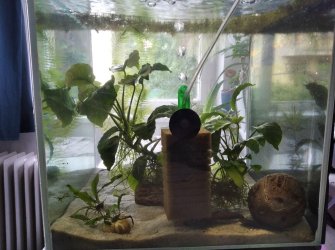Beastije
Fish Addict
So I did something a bit controversial. Still an advice would be appreciated.
At first the idea was to move my sterbais from the main tank in a trio to a separate tank for breeding. However when I visited a recent fish store I noticed that they are selling sterbais in basically the same size as I have, and those sold are juveniles. This lead me to realizing mine didnt do much growing and most likely are not getting fed enough. I have a mixed group of 13, some I have had for year and 8 months, some I have had only for 8 months. However they are around 3 cm, 3,5 cm the larger ones.
I decided to move them to a much much smaller tank (and yes, I know, too small for them), to feed them up, to get them going and ensure their diet is good for a while and controlled to look at them closely.
My question is, how long can I keep them in this too small tank, and how much should I really feed them to not do some damage.
The tank dimensions are 40x40x40 cm. It is established and since the picture was taken I added a large clump of moss on top of the coconut, I also added a bunch of oak/beech leaves to the tank.
For now I have fed once or twice a day and plan to do a water change every 4 days just to ensure the tank is clean. I fed live bloodworms, frozen ones, frozen mosquito larvae, dennerle crustagran, spirulina tablets (to ensure it is not too high protein).
I also have frozen tubiflex, bbs, cyclops, and dry fluval bug bites


At first the idea was to move my sterbais from the main tank in a trio to a separate tank for breeding. However when I visited a recent fish store I noticed that they are selling sterbais in basically the same size as I have, and those sold are juveniles. This lead me to realizing mine didnt do much growing and most likely are not getting fed enough. I have a mixed group of 13, some I have had for year and 8 months, some I have had only for 8 months. However they are around 3 cm, 3,5 cm the larger ones.
I decided to move them to a much much smaller tank (and yes, I know, too small for them), to feed them up, to get them going and ensure their diet is good for a while and controlled to look at them closely.
My question is, how long can I keep them in this too small tank, and how much should I really feed them to not do some damage.
The tank dimensions are 40x40x40 cm. It is established and since the picture was taken I added a large clump of moss on top of the coconut, I also added a bunch of oak/beech leaves to the tank.
For now I have fed once or twice a day and plan to do a water change every 4 days just to ensure the tank is clean. I fed live bloodworms, frozen ones, frozen mosquito larvae, dennerle crustagran, spirulina tablets (to ensure it is not too high protein).
I also have frozen tubiflex, bbs, cyclops, and dry fluval bug bites



